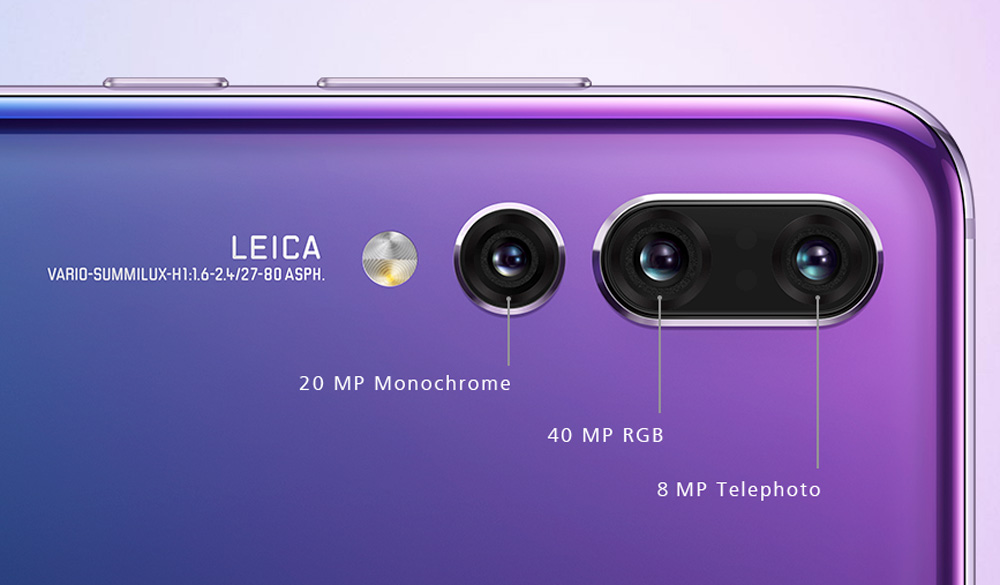

We may earn revenue from the products available on this page and participate in affiliate programs. Learn more ›

The first smartphone to boast a pair of rear-facing cameras for non-3D photography was the HTC M8 in 2014 It was Apple’s iPhone 7 Plus, however, that made the double-cam setup standard on flagship phones. Now, Huawei’s new P20 Pro phone packs a trio of rear-facing cameras, and things will likely only escalate from here. And while it may sound like a novelty, multiple imaging devices feed lots of photo and video data to increasingly powerful processors. This creates computational cameras with some real advantages over their cyclopean competition.
Here’s what each camera does.
Main camera
The primary imaging device on the P20 Pro is a typical smartphone camera with a well-above-average total resolution of 40 megapixels. It uses all those pixels by combining them in 2×2 groups—a technique called “binning”—and spitting out 10-megapixel images. Most smartphone cameras hover around the 12-megapixel mark, but that difference in final resolution doesn’t matter much when you consider that even a 4K UHD screen only requires a little over 8 megapixels to fill the display.
All those pixels can sound a warning signal for some camera nerds like me because cramming lots of pixels onto a small cellphone sensor can increase the chances for problems like digital noise in your photos. However, at 1/1.78 inches, the sensor inside the Huawei phone is roughly twice the size of what you find in other phones, like the 1/2.55 inch chip inside the Samsung Galaxy S9. With a bigger sensor, it can literally catch more light, which typically leads to less noise.

Telephoto camera
Apple started a trend with its iPhone 7 Plus and its additional telephoto camera that enabled its Portrait Mode. Huawei uses a similar setup here. The telephoto camera has an eight-megapixel sensor with a much smaller 1/4.4 inch sensor. The interesting part, however, is the lens sitting in front of it. The telephoto glass offers a much narrower field of view (roughly equivalent to an 80mm lens on a full-frame DSLR) which is a lot more flattering for things like portraits because they don’t distort the scene as much as a wide-angle.
The lens itself doesn’t let in as much light as the main camera’s lens (it has a maximum aperture of f/2.4 compared to f/1.8 on the wide-angle), but that’s expected and similar to the camera implementation on other phones. The telephoto lens, however, does have optical image stabilization built in, which means the glass elements within the lens move around as your hand shakes to neutralize the blur that would otherwise happen as a result.
Secondary camera
The third—and perhaps the most interesting—camera on the P20 Pro is a 20-megapixel sensor that only captures images in black-and-white. This isn’t for a cool effect or a gimmick, but rather this camera exists specifically to feed image data to the other imaging devices on the phone. It’s a support system.
The black-and-white camera looks out into a scene and pulls out specific data the phone can use for computational photography. For instance, it can help estimate how far images are from the front of the lenses, information that the processor can then use to help estimate fake blur that’s typically associated with portrait modes.
The monochrome camera also helps capture finer details because it doesn’t have color filters for determining the hues in an image. As a result, it can add detail to images during digital zoom, which typically involves a substantial loss of image quality.
Camera testing lab DXO Mark calls it the best zoom performance it has ever seen on a smartphone.
The additional detail from the monochrome image also helps push the low-light performance of the camera. According to the DXO test, it can reach a maximum ISO of 102,000+, which is on-par or better than some pro-grade DSLRs. Those pro cameras are reaching those heights with high-end sensors, but it’s impressive for a smartphone camera to even reach that level at all.
Expect to see more of this
Right now, two cameras are the norm on the backs of smartphones—although Google is doing a surprisingly good job with just one on its Pixel phones—but it wouldn’t be a surprise to see even more lenses popping up on the backs of mobile devices. A camera like the Light L16 takes this concept to the extreme with an arsenal of individual imaging devices, each with a specific purpose and point-of-view.
Unless smartphones start getting thicker, or new lens tech like liquid lenses starts to become a lot more practical, it wouldn’t be a surprise if the back of your phone continues getting a little more crowded with cameras.
